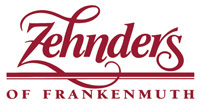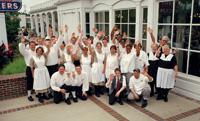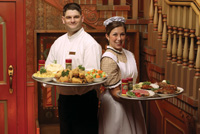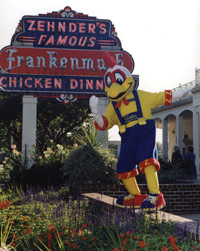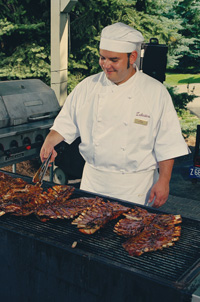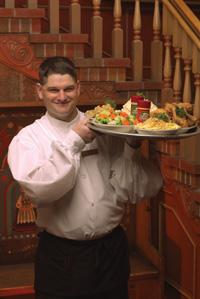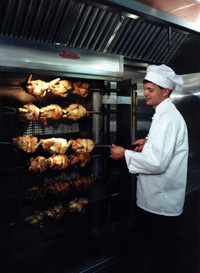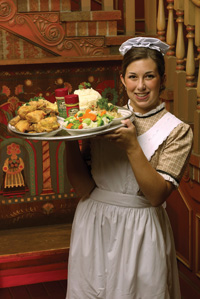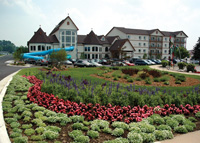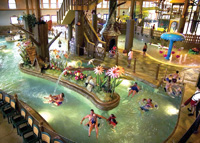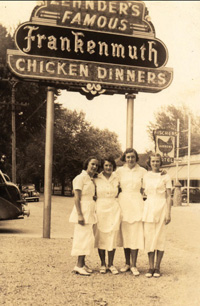|
By Debra Hindlemann Webster Spending time at Zehnder’s is like walking into a Hallmark card: There is no other way to describe it. This is America’s largest family restaurant and second-largest independently owned one. It also sports a 152-room hotel with a 20,000-square-foot video arcade, a championship18-hole golf course and country club, a four-story 30,000-square-foot water park, and a good-sized retail food/bakery/boutique outlet. This single campus is located in Frankenmuth, Mich., in the Saginaw Valley between the cities of Flint and Saginaw, northwest of Detroit. Zehnder’s was originally a hotel built in 1856 used as a stop-over for farmers who wanted a friendly fried chicken meal, hay and water for their horses, and a place to bed down all for the nifty fare of $.75 a night. It passed from owner to owner since then, and was eventually purchased by William and Emilie Zehnder in 1927, who eliminated the hotel and turned it into a restaurant instead. Zehnder’s opened on Mother’s Day, 1928, and it’s still their biggest holiday crowd. The couple completely remodeled it and, being German Lutheran immigrants who recognized their great fortune to have been Americans, decided that the new establishment would resemble the Colonial-styled residence of Mt. Vernon, President George Washington’s pastoral home in Virginia. It looks much the same today. As with most family concerns, William ran the hotel, and Emilie cooked the food. For the most part, her recipes are still used. The couple had eight children, and in one way or another, every son or daughter was put to work to keep the family business alive. The brothers and sisters remained close as relatives, as well as being smart, savvy business colleagues. During the Depression, they struggled desperately, like many business owners of the time. Their lowest day was in the 1930s, when they sold a single seven-cent Speckled Sport cigar. That’s a far cry from today’s receipts, with the multiple dining rooms serving as many as 5,916 guests in one day; at approximately $20 a person, that’s good business! The Saginaw Valley community came about in 1845, when an influx of German immigrants migrated to the area. What was then about 3,000 people grew to approximately 5,000, and it hasn’t changed much over the last 163 years. The growth of the automotive industry as a result of the presence of an interstate in the 1950s caused heavier population and changes in demographics. However, the surroundings of Frankenmuth are basically farming community and small towns where everybody knows everybody. The church unites the population and promotes family values that are very traditional and conservative in perspective. This is a community of closely knit and caring people. The old-fashioned tried and true Protestant ethic hard work is the core for everyone, every day. Zehnder’s is a paradigm. Edwin, son of William, eventually took over Zehnder’s. However, the rest of the family didn’t stray far. One sister ran the gift shop, a brother was the postmaster of the town, one became a minister with a son who is now the head chef of the restaurant, one a professor of hospitality management, and William Jr., who ran the Austrian restaurant across the street. Now, in the third generation of ownership, all of whom are in their 50s, Zehnder’s is run by Edwin’s four children. They work together and they vacation together, celebrating the holidays on their own time before opening the doors to their customers. “We are grateful to have what we do,” says Susan Zehnder, vice president of human resources. “We think of ourselves as being very fortunate.” Everyone cooks, serves, bakes, you-name-it. And the best part? The farmers in the surrounding area supply the chickens, vegetables, and grain for the breads. To accommodate the customers’ dietary needs as well as the desire for fresh homegrown items, very little processed food is served. “The secret,” confesses Susan, “comes from Dad. He always said that no one works for him; everyone works with him.” There are more than 700 employees affiliated with the Zehnder’s corporation, some workers marking 35- or 50-year anniversaries. Every aspect is overseen and neatly divided by job description in tune with specific areas of activity. The basic philosophy of uniforms, the same as with the restaurant, is the simple, down-to-earth system that has kept the company running for so many years. “Guests, like everyone else, judge a book by its cover,” says Susan, in Trumanesque plainness. The garments are mostly utilitarian with an eye for cost, and beyond that, they are quite straightforward. The employees, themselves coming from the surrounding rural areas, are quite like-minded, so the down-home atmosphere of the restaurant spills over from them, as well. The most that’s spent on classified ads for hiring new people is $600 per year. Everyone else is either family or a referral. Folks don’t fight because there’s little to fight about; they’re too busy working for a day’s pay, rather than frittering away time with arguments. Trust runs high, and friends respect friends. The garments that they wear are reflective of themselves, and they are practical for job service. “Our company goal is that everyone leaves satisfied,” reports Susan. “Customer service is number one. We want to be the number one choice for our guests, our employees, as leaders in our local community, region, state, and nationally, where we work very hard to be good citizens.” There are four areas for uniform wear: The restaurant itself, which capitalizes on its Williamsburg-styled Colonial architecture, surroundings, costumes, and fried chicken dinners with all the fixin’s; the retail outlet that merchandises homemade bakery goods, food and a few what-nots; the lodge with the adjoining water park; and the golf course with its clubhouse. The restaurant is really the only place where there are unique costumes. The design, instituted in the 1960s, is very simple and with low-key colors in browns and beiges with black and white accents. The female servers wear ankle-length plaid Colonial dresses with white eyelet lace pinafore aprons. Mop caps and puffed sleeves with pleats and velvet ribbons accentuate the style. The men wear large white peasant shirts and black knickers. Hostesses dress in black floor-length dresses with impressive eyelet pinafore collars. The bartenders wear vests, slacks and ties. When it comes to “fancy wear,” that’s it for the entire expanse of property. Everything else is strictly comfort, practicality, and job-description oriented. The retail area employees are outfitted in black cobbler aprons. No muss, no fuss. They’re worn over an employee’s basic dress, and serve to identify and to keep the individual clean. Once a year, each employee is given a free uniform from Zehnder’s. If an employee wants additional garments, he must purchase them. This is throughout the establishment. The hotel staff is outfitted in khaki pants and polo shirts. Certainly, there are white chef coats for the kitchens, and black or black and white checkered chef pants, which are everywhere on campus. But the employees at the hotel as well as the golf club, maintenance facility and elsewhere are dressed in the khaki pants and polo shirts. If the heath department requires a hat, then it’s a black baseball cap. The polos are color-coded by job description: royal for those working in the Splash Village water park dining room, red for the water park itself, white for the front desk and professional staff, burgundy for the maintenance people, etc. Susan chooses the colors, and with her assistant and various area managers, the uniforms are kept in perfect condition. The state of Michigan mandates that every employee must be fitted in a uniform, so certain items in the Zehnder’s line have to be custom-made to accommodate people who are particularly large or small. “Weight is a protected class,” Susan cites, “so ‘buying off the rack’ is impossible.” She tries to work with as few vendors as possible to narrow the multiple efforts for fitting and purchasing uniforms. Before each uniform article is purchased, the item is tested by employees for fabric durability, quality, laundry performance, stain resistance, comfort and employee opinion. Susan is the bottom line when it comes to selection, but employees always have a say in what they wear. Enough stock is kept on hand for new hires or unexpected damages. Each employee is expected to take care of his own uniform. There are spreadsheets that record each employee and what is given out at time of hire and orientation. The uniform stockroom is stocked full in the busy months but dwindles down as the tourist season passes. Also, different areas are recorded separately. For instance, the golf season may require a varying level of in-stock apparel versus the dining rooms. Including part-time employees, there are several thousand sets of uniforms that are in use on a regular basis, as most workers have at least three sets of garments. Tailors in the surrounding area are recommended, but Zehnder’s itself does not have its own alteration department. When a new employee is taken on, he ventures into the fitting room and is supervised by his area manager, who makes sure that he has the correct items and is appropriately and attractively attired. There is very little, if any, desire to revamp the uniform program. “If it isn’t broke, don’t fix it” is the motto. “We consider freshening things up a bit from year to year, but that’s it,” says Susan. “We’re happy. People know who we are. Our uniforms identify us in a way that’s easy. If we put only our uniforms on a billboard, we wouldn’t even have to use our name because our guests know us when they see us.” The employees are shown how to iron, how to sew on their buttons or fix a tear and how to clean their own garments. Sloppiness is not permitted. One has to look as good as possible. If a worker arrives in a uniform that is less than “bandbox,” then he is sent home without pay. If a garment is dirty or torn, there is no pay for the time spent repairing it on the job. Tattoos, appropriate undergarments, jewelry and shoes are all discussed, and expectations are clearly defined. Understanding the basic philosophy of Zehnder’s of Frankenmuth may appear to be somewhat old fashioned or even odd in today’s world. But the other side of it is longevity. How many can say particularly in this day and age that they’ve survived 82 years including multiple wars, a depression, recessions, strikes and plain hard times? Through all of that, Zehnder’s has grown and remodeled. Zehnder’s, in its down-home, no frills, brass tacks simplicity, is just plain heart-warming. It’s about American success and the basic values that this country was made of. Think about it, go there, try it. And smile.
|
|
| Above story first appeared in MADE TO MEASURE Magazine, Spring & Summer 2009 issue. All rights reserved. Photos appear by special permission. | |
| Halper Publishing Company 633 Skokie Blvd, #490 Northbrook, IL 60062 (877) 415-3300 Fax (224) 406-8850 [email protected] |
|




